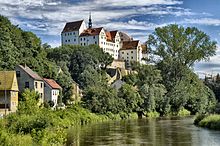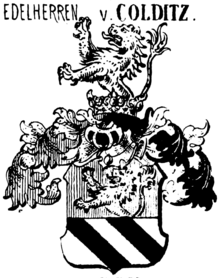Colditz (noble family)
Colditz (also Kolditz ) is the name of an old Saxon , in Bohemia , Moravia and Silesia settled noble family .
history

The name of the race goes to the ministerials Thimo back, whose castle Colditz in Saxony in 1158 by Emperor Barbarossa as part of the splices country was raised to the imperial. The Saxon Junker Thimo I von Colditz built the Rosenburg in Graupen ( Krupka ) in 1330 . His successor was his son Thimo II and the grandson Thimo III. Count Thimo II, chamber master of Emperor Karl IV and governor of Upper Lusatia and Silesia inherited Graupen Castle in northern Bohemia when his father died in 1341 and in 1364 sold the Hartenberg Castle in north-west Bohemia to Emperor Karl IV Thimo VII ., was Marshal of Margrave Frederick the Strict of Meissen and in 1369 became governor of Breslau . Thimo VIII., Since 1348 court marshal and chamberlain of the emperor Charles IV. , Achieved great importance. In 1378 he acquired the rule of Eilenburg , in 1379 the pledge of Pirna and in 1382 Neuseeberg in Bohemia . Thimos VIII's loyal service to the emperor brought him rich estates in Bohemia. As early as 1318, a stately Colditz mint was recorded in which pennies minted on one side were struck by dynasty bracteates . Thimo V. auf Graupen sold the Graupen estate to Kaspar von Schönburg in 1557 .
According to the family tree of the British Prince Charles , those of Colditz belong to his ancestors. So in the 16th generation Dorothea von Colditz (* 1480 - † 1520), in the 17th generation Johanna von Colditz and Thimo von Colditz († 1508) and in the 18th generation Hans von Colditz .
After the Colditz rule fell to the Wettins in 1404 , they established the Colditz office with its seat in Colditz Castle . The Bohemian line is said to have died out after 1620.
Personalities
- Kolda von Colditz , Dominican
- Ulrich I von Colditz († 1315), Bishop of Naumburg (1304-1315)
- Withego II of Colditz († 1342), Bishop of Meißen (1312–1342)
- Thimo VII. Von Colditz, bailiff of Upper Lusatia , around 1355–1366
- Thimo VIII von Colditz (documented evidence from 1354 to 1374), since 1348 court marshal and chamberlain of the German emperor and Bohemian king Karl IV
- Thimo von Colditz († 1410), Bishop of Meissen (1399-1410)
- Albrecht von Kolditz († 1448), captain of Schweidnitz-Jauer, Breslau and Upper Lusatia
- In 1248 as a royal: Volrad Colditz (?) Provincial judge in Pleissenland occupied
coat of arms
The coat of arms is divided, two slanted black bars on silver below , a growing golden lion with outstretched paws on top of red . On the helmet a lion and an eagle, which corresponds to the coat of arms of Görlitz . The helmet covers are red and gold on the right and black and silver on the left.
In the coat of arms of the city of Colditz , the coat of arms of those of Colditz is depicted differently: above a growing black lion on a gold background, below three to the right falling (oblique) red bars on a silver (white) background: Colditz coat of arms .
On the genesis of the coat of arms
The growing lion was evidently borrowed from the coat of arms of the original Staufer estate Pleißenland . Its central administration was located in the Kaiserpfalz in Altenburg, today's Altenburg Castle , where the Burgraves of Altenburg sat as Ministeriale, whose coat of arms (rose) can also be found in the Colditz city coat of arms (left).
In the extended coat of arms (from 1597) of the related Counts of Stolberg, there are also growing black lions on a golden background as well as growing golden lions on a red background in two other fields: Stolberg (noble family) #Wappen .
Coat of arms of the Staufer Pleißenland
Secondary lines
On Castle Wolkenburg in the valley of the river Mulde sat before 1409, the "Lords of Wolkenburg", a branch line of the Reichsministerialen Colditz who took their name from this castle. The following are occupied:
- Ulrich II of Wolkenburg, 1215–1277
- Heinrich IV von Wolkenburg in 1309
- Volrad V. von Wolkenburg died in 1338
Another branch line sat at Wasserburg Breitenhain near Lucka and named itself after this castle and rule. Breitenhain Castle was demolished in 1981 during the GDR era. As early as 1279, a Thimo von Breitenhain -from the von Colditz family- was mentioned in a document. Count Heinrich IV. From the Stollberg ( Stolberg ?) Family married Jutta von Breitenhain from the von Colditz family around 1270.
literature
- Johann Sinapius : Schlesische Curiositäten , 1720, Volume 1 p. 524 and Volume 2 p. 738
- Johann Friedrich Ursinus: The history of the cathedral church in Meissen: historically and diplomatically explained from its tombs, together with a prospectus of the cathedral church , Verlag Walther 1782, p. 73
- Christian Friedrich August von Meding : Nachrichten von noble Wapen , 1788, Volume 2, pp. 315-316
- Ernst Heinrich Kneschke : New general German nobility Lexicon , 1864, Vol. 2, pp. 304-306
- Kurt Truöl: The Lords of Colditz and their rule , 1914
Individual evidence
- ↑ Reg.imp. from January 1, 1158
- ↑ Viktor Karell : Castles and palaces of the Ore Mountains and Egertal. Vol. 1, Vinzenz Uhl Verlagbuchhandlung, Kaaden , 1935. ("Die Rosenburg bei Graupen" p. 80, "Schloß Hartenberg" p. 17)
- ^ Walter Schlesinger , edited by Thomas Lang: Contributions to the history of the city of Glauchau. Edited by Enno Bünz. Thelem Verlag, Dresden 2010, p. 53.
- ↑ Eduard Machatschek : History of the bishops of the Meissen Monastery in chronological order (...) . Dresden 1884. p. 359.
- ↑ Wolf-Dieter Röber , Steffen Winkler : "Schloß Wolkenburg", In: Series of publications Heft 6, Museum and Art Collection Schloss Hinterglauchau, City of Glauchau, 1986, GDR, "Herren von Wolkenburg" p. 25
- ^ Branch line "von Breitenhain" of Colditzer




